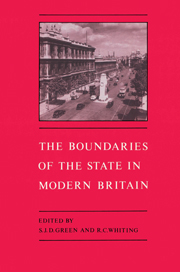Book contents
- Frontmatter
- Contents
- List of figures
- List of tables
- List of contributors
- Acknowledgements
- 1 Introduction: the shifting boundaries of the state in modern Britain
- Part I The state and political theory
- Part II The economy
- Part III Welfare and social policy
- Part IV Conflict and order
- Part V Religion and morality
- 14 Survival and autonomy: on the strange fortunes and peculiar legacy of ecclesiastical establishment in the modern British state, c. 1920 to the present day
- 15 Religion and the secular state
- 16 The British state and the power of life and death
- 17 Conclusion: on the past development and future prospects of the state in modern Britain
- Index
16 - The British state and the power of life and death
Published online by Cambridge University Press: 18 March 2010
- Frontmatter
- Contents
- List of figures
- List of tables
- List of contributors
- Acknowledgements
- 1 Introduction: the shifting boundaries of the state in modern Britain
- Part I The state and political theory
- Part II The economy
- Part III Welfare and social policy
- Part IV Conflict and order
- Part V Religion and morality
- 14 Survival and autonomy: on the strange fortunes and peculiar legacy of ecclesiastical establishment in the modern British state, c. 1920 to the present day
- 15 Religion and the secular state
- 16 The British state and the power of life and death
- 17 Conclusion: on the past development and future prospects of the state in modern Britain
- Index
Summary
One of the few striking abdications of power by the British state in the twentieth century has been the abandonment of its power to execute individual citizens. In some measure this was a continuation of a nineteenth-century trend in which the death penalty had been abolished step by step for a large number of offences, so that from 1861 civilians could only be executed for four offences; murder, high treason, piracy with violence and the destruction of naval dockyards and public arsenals. Executions for the latter offences have been somewhat rare in the twentieth century and in general the execution of civilians in peacetime has been confined to those found guilty of murder. The conventional view is that no further major changes took place until the Homicide Act of 1957 which divided murder into capital and non-capital murder, the majority of murders being rendered non-capital. In 1965 capital punishment for murder was suspended for five years and at the end of that period abolished altogether. Since then several attempts have been made to restore capital punishment, either for all murders, or for particular types of murder, but none has succeeded. In each case, except for the 1957 Homicide Act, changes in the law, or attempts to change it, have been initiated by individual Members of Parliament and decided by a formally free vote, unlike government-sponsored legislation, which usually involves strictly controlled voting along party lines.
- Type
- Chapter
- Information
- The Boundaries of the State in Modern Britain , pp. 341 - 374Publisher: Cambridge University PressPrint publication year: 1996
- 2
- Cited by



